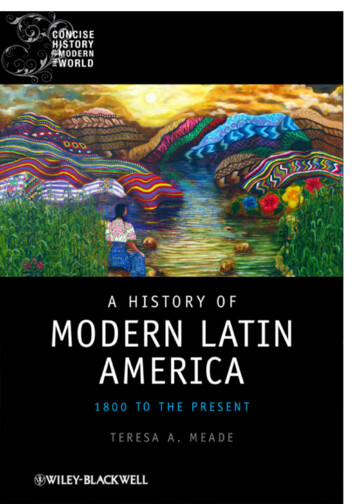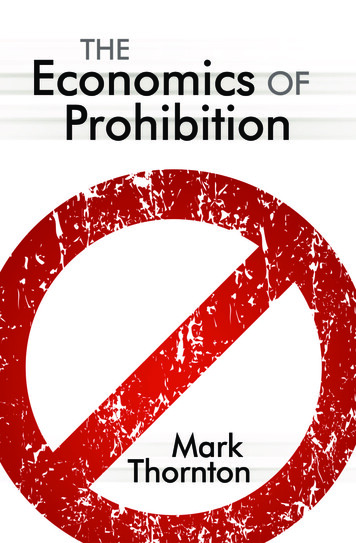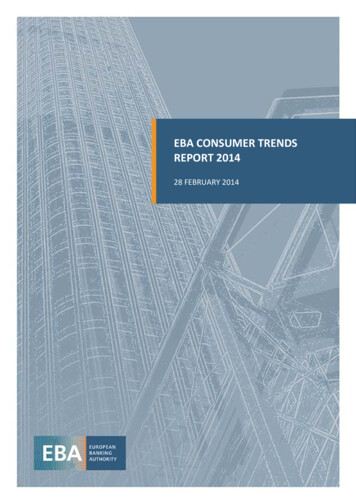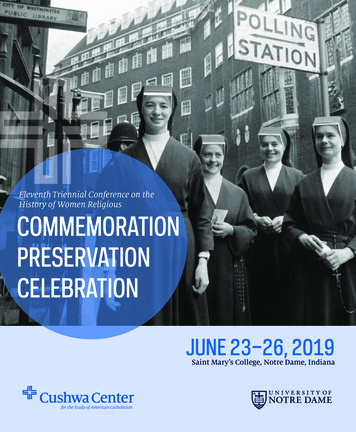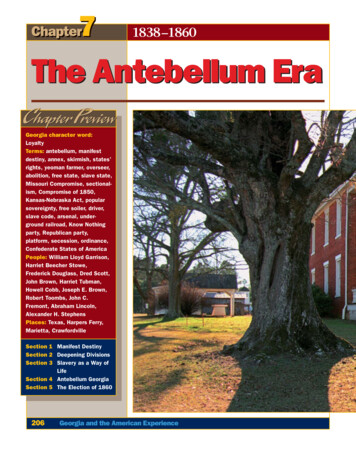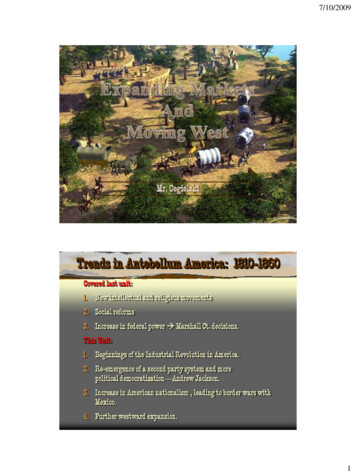
Transcription
7/10/2009Mr. CegielskiTrends in Antebellum America: 1810-1860Covered last unit:1.New intellectual and religious movements2. Social reforms3. Increase in federal power Marshall Ct. decisions.This Unit:1.Beginnings of the Industrial Revolution in America.2. Re-emergence of a second party system and morepolitical democratization—Andrew Jackson.3. Increase in American nationalism , leading to border wars withMexico.4. Further westward expansion.1
7/10/2009Complete this warm up:2
7/10/2009ESSENTIAL QUESTION:3
7/10/2009James Watt invented theSteam Engine ActivityChallenge: Using thisdiagram alone,explain howyou think thesteam engineworked.Three to foursentencesplease! 4
7/10/2009Steam TractorFirst Turnpike- 1790 Lancaster, PABy 1832, nearly 2400 mi. of road connectedmost major cities.5
7/10/2009Cumberland (National Road),1811Conestoga Covered WagonsConestoga Trail, 1820s6
7/10/2009Erie Canal SystemErie Canal, 1820sBegun in 1817; completed in 18257
7/10/2009Robert Fulton& the Steamboat1807: The ClermontSteam Ship8
7/10/2009Principal Canals in 1840Inland Freight Rates9
7/10/2009Clipper ShipsASSIGNMENTS: CANALS!Directions: Read and complete “PERSONALSTUDY: CANALSTHE BRIDGEWATERCANAL” which explains how canals firstfunctioned in Great Britain. Then, read“Traveling the Erie Canal, 1836” fromeyewitnesstohistory.com. Using theknowledge you gained, sketch a diagram ofhow the locks in the Erie Canal worked. Ifneeded, conduct some extra Internetresearch for this.10
7/10/2009Steam leads to the development of Railways:Economic Impact Travel Time and SpaceThe Development of the Railroad:George Stephenson1825The Rocket11
7/10/2009Just a museum relic now .An Early Steam Locomotive12
7/10/2009Later LocomotivesTheRailroadRevolution,1850s Immigrant laborbuilt the No. RRs. Slave laborbuilt the So. RRs.13
7/10/2009ASSIGNMENT—EYEWITNESS REPORT!:Q. Which was faster: a horse-drawn carriage attop speed or the 1st locomotive? Read “America'sFirst Steam Locomotive, 1830.” Acting as aneyewitness reporter in 1830, describe this actualrace between a train and a horse carriage in a200-word newspaper-style article! In addition, usethe information from the reading to draw a sketchof the race to include with your article!14
7/10/2009The “Iron Horse” Wins! (1830)1830 13 miles of track built by Baltimore & Ohio RRBy 1850 9000 mi. of RR track [1860 31,000 mi.]15
7/10/2009Resourcefulness &Experimentation Americans were willing to tryanything. They were first copiers, theninnovators.1800 41 patents were approved.1860 4,357 “““Eli Whitney’s Cotton Gin, 1791Actually inventedby a slave!16
7/10/2009Eli Whitney’s Gun FactoryInterchangeable Parts RifleOliverEvansFirst automated flourmillFirst prototype of the locomotive17
7/10/2009John Deere & the Steel Plow(1837)Cyrus McCormick& the Mechanical Reaper: 183118
7/10/2009Samuel F. B. Morse1840 – TelegraphCyrus Field& the Transatlantic Cable, 185819
7/10/2009Elias Howe & Isaac Singer1840sSewing MachineThe “American Dream”zThey all regarded material advance asthe natural fruit of Americanrepublicanism & proof of the country’svirtue and promise.A German visitor in the 1840s, FriedrichList, observed:Anything new is quickly introduced here,including all of the latest inventions.There is no clinging to old ways. Themoment an American hears the word“invention,” he pricks up his ears.20
7/10/2009Boom/Bust Cycles: 1790-1860The blue line shows, for comparison, the priceof a year’s tuition at Harvard College. In 1790it was 24, but by 1860 had risen to 104.21
7/10/2009Creating a Business-Friendly ClimateSupreme Court Rulings:* Fletcher v. Peck (1810)* Dartmouth v. Woodward (1819)* McCulloch v. Maryland (1819)* Gibbons v. Ogden (1824)* Charles Rivers Bridge v. WarrenBridge (1835)General Incorporation Law passedin New York, 1848.Laissez faire BUT, govt. did muchto assist capitalism!Distribution of WealthvDuring the American Revolution,45% of all wealth in the top 10% ofthe population.v1845 Boston top 4% owned over65% of the wealth.v1860 Philadelphia top 1% ownedover 50% of the wealth.vThe gap between rich and poor waswidening!22
7/10/2009Samuel Slater(“Father of the Factory System”)The Lowell/Waltham System:First Dual-Purpose Textile PlantFrancis Cabot Lowell’s town - 181423
7/10/2009Lowell in 1850Lowell Mill24
7/10/2009Early Textile Loom25
7/10/2009Life During the Industrial Rev. VideoA quiz follows this program so pay attention!I’m testing your listening skills this time!26
7/10/200927
7/10/2009New EnglandTextileCenters:1830s28
7/10/2009New England Dominance inTextilesStarting for Lowell29
7/10/2009Lowell GirlsWhat was their typical “profile?”Lowell Boarding HousesWhat was boardinghouse life like?30
7/10/2009Lowell MillsTime TableEarly“Union”Newsletter31
7/10/2009The Factory Girl’s GarlandFebruary 20, 1845 issue.I’m a Factory Girl Filled with WishesI'm a factory girlEveryday filled with fearFrom breathing in the poison airWishing for windows!I'm a factory girlTired from the 13 hours of wok each dayAnd we have such low payWishing for shorten work times!I'm a factory girlNever having enough time to eatNor to rest my feetWishing for more free time!I'm a factory girlSick of all this harsh conditionsMaking me want to sign the petition!So do what I ask for because I am a factory girlAnd I'm hereby speaking for all the rest!32
7/10/2009Irish Immigrant Girls at LowellThe Early Union MovementWorkingman’s Party (1829)* Founded by Robert Dale Owen andothers in New York City.Early unions were usually local, social,and weak.Commonwealth v. Hunt (1842).Worker political parties wereineffective until the post-Civil Warperiod.33
7/10/2009ASSIGNMENT: EXPOSE AT THELOWELL FACTORIES!Directions: Analyze the primary source documents provided as well asthe reading “The Rules and Regulations of New England Mills” and “WeCall On You to Deliver Us From the Tyrant’s Chain”: Lowell WomenWorkers Campaign for a Ten Hour Workday” and complete theseactivities:1) Identify and describe the working and living conditions of the"Lowell Girls."2) Imagine that you are a writer for an expose magazine.Conduct an imaginary interview with the Lowell girls and thefactory owners. This two-page dialogue should read like aquestion-answer session and include your analysis andconclusions about what positive changes need to be made inthe Lowell factories.34
7/10/2009Regional SpecializationEAST IndustrialSOUTH Cotton & SlaveryWEST The Nation’s “Breadbasket”American Population Centers in182035
7/10/2009American Population Centers in1860National Origin of Immigrants:1820 - 1860Why now?36
7/10/2009KnowNothingParty:“The SupremeOrder of theStar-SpangledBanner”Changing Occupation Distributions:1820 - 186037
The Democratization ofAmerican Society:Politics and Presidential Administrationsfrom 1828-1844Mr. Cegielski38
the reading "The Rules and Regulations of New England Mills" and "We . Star-Spangled Banner" Changing Occupation Distributions: . Politics and Presidential Administrations from 1828-1844 Mr. Cegielski. Title: Manifest Destiny Author: Ms. Susan M. Pojer Created Date: 7/10/2009 6:31:21 PM .




